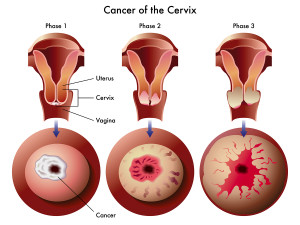Introduction and statistics
It is important to realize that cervical cancer is the 3rd most common cancer of the gynecological cancers in women. Fortunately there has been a dramatic improvement from the past. For one thing, those women, who get checked regularly (yearly) with Pap tests, will not progress to invasive cervical cancer. Instead they will have their precancerous lesions removed. To explain, if a woman had 3 or more satisfactory Pap test readings at yearly intervals, the Pap test can be performed less frequently at the discretion of her treating physician, if she belongs into the low-risk category.
Low-risk and high-risk parameters for decision on frequency of Pap test
______________________________________________________
Low-risk group: Never had sex (e.g. nuns), had hysterectomy for non-cancerous disease. Age 60 or older after regular Pap screen without abnormal smear
At-risk group: Age 18 and older, Sexually active
High-risk subgroup: early sex with multiple partners
______________________________________________________
On the other hand, if she is classified as belonging into the at-risk group, notably, most physicians would recommend a yearly Pap test until the Pap smear pattern is established. At his point the frequency might be lessened based on the cytology data. However, there is a high-risk subgroup of women who had sex very early in their teenage years with multiple partners, which puts them, as we will see below, into a high risk for papilloma (from exposure to human papilloma virus, HPV) that can lead to precursors of cervical cancer. It appears that HPV exposure in women determines whether or not she belongs to a low-risk or at-risk group.
Cancer in situ
Another key point, cancer of the cervix develops out of clusters of cancer cells (cancer in situ), which develop years before the invasive cervical cancer occurs. In general, the peak for cancer in situ is at age 25 to 40. On the contrary, invasive cancer has a peak at the age of 48 to 55.
A point often overlooked, every year in the U.S. 65,000 new cases of carcinoma in situ are diagnosed in women and every year 15,800 invasive cervical cancers are found as well. Furthermore, every year 4,800 women die from invasive cancer, which amounts to 2% of all cancer deaths in women or 18% of all gynecological cancers in women.
The sad part is: if all these women had gone for a yearly Pap test, almost none of them would have died!
References
1. Cancer: Principles &Practice of Oncology.4th edition. Edited by Vincent T. DeVita, Jr. et al. Lippincott, Philadelphia,PA, 1993. Chapter on gynecological tumors.
2. Cancer: Principles&Practice of Oncology. 5th edition, volume 1. Edited by Vincent T. DeVita, Jr. et al. Lippincott-Raven Publ., Philadelphia,PA, 1997. Chapter on gynecological tumors.
3. WG Quint et al. J Pathol 2001 May;194(1):51-58.
4. A Duenas-Gonzalez et al. Am J Clin Oncol 2001 Apr;24(2):201-203.
5. BD Kavanagh et al. Am J Clin Oncol 2001 Apr;24(2):113-119.
6. K Nakanishi et al. Skeletal Radiol 2001 Mar;30(3):132-137.
7. M Follen et al. Cancer 2001 May 1;91(9):1758-1776.







